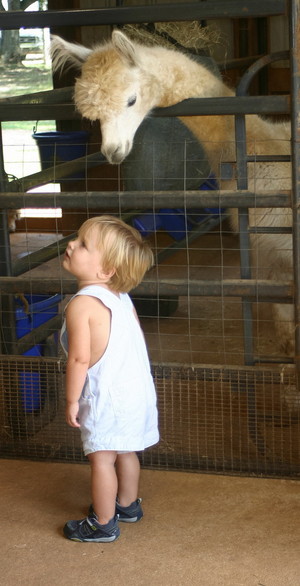25 Mar Wed 2009
Alpaca Shearing Day

We shear the alpacas once a year. Since we do a large number (77 this year), it works best for us to have a professional shearer come in and to do it all in one day. Our shearer is Mark Loffhagen who lives in Colorado. Mark and his team travel around the USA and shear over 7,000 alpacas a year. Each year he brings a “head man”. This year it was Jason from Wisconsin. The head man is Mark’s right hand man and moves the alpaca into the different positions as Mark shears. Jason also trimmed teeth and worked some ropes.

I thought I’d walk you through what happens here at Fairhope Alpacas on shearing day. We start with white animals, then light fawn (pictured above), darker fawns, browns, greys, and blacks are last. This keeps the fleeces from getting contaminated by darker colored fibers.
This year we used a blower to blow all the excess dust off the fleece before we brought the alpacas inside for shearing. We did NOT blow the fleeces that we intend to show as that would disturb the natural architecture of the fleece. However, I want to utilize the rest of my fleeces for my fiber biz this year so I decided to try getting the dust out before we sheared. (We will also process last year’s show fleeces this year.) To begin, the animals are walked in, by color (above).

Our shearer uses ropes to stretch out each alpaca. This restraint keeps the animal still, which helps to prevent them from getting cut during the shearing process. When we started shearing over 50, we began to use two stations. Notice in the background there is another station where another alpaca will be shorn. After the shearer is finished with one alpaca, he can quickly move to the next station to shear another one without having to wait for us to move that one, clean up, and bring him another one. This makes the process run more smoothly and enables us to shear up to 100 alpacas in a day. Though today we only had 77 to do.

The ropes are put above their feet, and the rope man pulls them to the proper amount of tightness so that the animal is comfortable, yet cannot flop around and injure itself. Above is Mac, working the ropes. (Mac is the greatest - be sure to stop by his blog)

Steve snuggles up with Rose Point as she awaits her turn.

Above, Andy trims toenails.
While the alpacas are restrained we take care of other herd health measure such as administering any shots that need to be given and we trim the teeth and toenails on those alpacas that need it.
 The bags we will be putting the fleeces into are labeled prior to shearing day. We owe a huge thank-you to Jodi for doing this! Clear plastic bags are preferable, often we purchase shredder bags from an office supply store. Each alpaca has a bag for it’s prime or blanket fleece. This is their best grade of fleece and is what is used for next-to-skin products. Then we have a bag for their seconds, usually neck fiber. It is usually a bit shorter and can be a bit more coarse than the blanket. Last is the thirds which is the belly, lower legs, and the rest of the fibers. This fiber is usually the most coarse and can be used in rugs and other products that don’t have to be very soft.
The bags we will be putting the fleeces into are labeled prior to shearing day. We owe a huge thank-you to Jodi for doing this! Clear plastic bags are preferable, often we purchase shredder bags from an office supply store. Each alpaca has a bag for it’s prime or blanket fleece. This is their best grade of fleece and is what is used for next-to-skin products. Then we have a bag for their seconds, usually neck fiber. It is usually a bit shorter and can be a bit more coarse than the blanket. Last is the thirds which is the belly, lower legs, and the rest of the fibers. This fiber is usually the most coarse and can be used in rugs and other products that don’t have to be very soft.
Each alpaca also has its own ziploc bag where we put a 2" x 2" sample that comes from the mid-side of the blanket fleece. We send this sample to Yocom McColl for testing. The test results will tell us how fine the fiber is, how uniform it is, and how much variation there is in the sample. In the picture above, don’t miss the weeds flowers the kids brought me during shearing. They’re sweeties. Here Pink Cyclone is being shorn. The lovely ladies in the picture are the fiber crew (left to right: Jodi, Carmie, and Sarah of Sierra Echo Accoyo Alpacas.) They help pick up the fiber as it comes off the animal and put it into bags. Merci Beaucoup!
Here Pink Cyclone is being shorn. The lovely ladies in the picture are the fiber crew (left to right: Jodi, Carmie, and Sarah of Sierra Echo Accoyo Alpacas.) They help pick up the fiber as it comes off the animal and put it into bags. Merci Beaucoup!

Then the bags were handed to Mary for weighing. Mary is a wonderful spinner who is always helpful to us on the farm! During many of our Farm Events, she and Mac can be found conducting spinning demonstrations and even giving spinning lessons. The white bundles on the table (pictured above) are our show fleeces.

